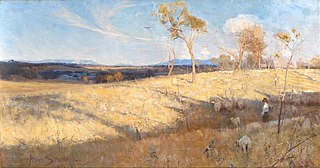
The Heidelberg School was an Australian art movement of the late 19th century. It has been described as Australian impressionism.

The Royal Exhibition Building is a World Heritage-listed building in Melbourne, Victoria, Australia, built in 1879–1880 as part of the international exhibition movement, which presented over 50 exhibitions between 1851 and 1915 around the globe. The building sits on approximately 26 hectares, is 150 metres (490 ft) long and is surrounded by four city streets. It is at 9 Nicholson Street in the Carlton Gardens, flanked by Victoria, Carlton and Rathdowne Streets, at the north-eastern edge of the central business district. It was built to host the Melbourne International Exhibition in 1880–81, and then hosted the even larger Centennial International Exhibition in 1888, and the formal opening of the first Parliament of Australia in 1901. The building is representative of the money and pride Victoria had in the 1870s. Throughout the 20th century smaller sections and wings of the building were subject to demolition and fire; however, the main building, known as the Great Hall, survived.

Raymond John Paul Parer was an Australian aviator.

The Carlton Gardens is a World Heritage Site located on the northeastern edge of the Central Business District in the suburb of Carlton, in Melbourne, Australia. A popular picnic and barbecue area, the heritage-listed Carlton Gardens are home to an array of wildlife, including brushtail possums.

David Damien Parer ACS is an Australian natural history film maker, working in partnership with his wife and sound recordist, Elizabeth Parer-Cook.

Exhibition Street is a major street in the Melbourne central business district, Australia. The street is named after the International Exhibition held at the Royal Exhibition Building in 1880, and was previously known as Stephen Street from 1837. The street runs roughly north–south and was laid out as part of the original Hoddle Grid.

Damien Peter Parer was an Australian war photographer. He became famous for his war photography of the Second World War, and was killed by Japanese machine-gun fire at Peleliu, Palau. He was cinematographer for Australia's first Oscar-winning film, Kokoda Front Line!, an edition of the weekly newsreel, Cinesound Review, which was produced by Ken G. Hall.
The following lists events that happened during 1888 in Australia.
Warwick Raymond Parer, AM was an Australian politician who served as a Senator for Queensland from 1984 to 2000. He was a member of the Liberal Party and served as Minister for Resources and Energy in the Howard government from 1996 to 1998.

The Melbourne International Exhibition is the eighth World's fair officially recognised by the Bureau International des Expositions (BIE) and the first official World's Fair in the Southern Hemisphere.

Meinhard's Bitters was created and manufactured by Dr. Teodoro Meinhard, a German-born resident of Venezuela, and the founder of Meinhard & Company. The full and exact name of Meinhard's Bitters is subject to some historical and legal question, and certainly changed over time. This brand of bitters came into existence in 1866 in Upata, Venezuela and manufacture moved in 1870 to Ciudad Bolívar Venezuela. The recipe was also licensed to Von Glahn Bros. and distributed as Caroni bitters in North America by 1893.

The 9 by 5 Impression Exhibition was an art exhibition in Melbourne, Australia. It opened on 17 August 1889 at Buxton's Rooms on Swanston Street and featured 183 works, the majority of which were painted by Charles Conder, Tom Roberts and Arthur Streeton of the Heidelberg School art movement, also known as Australian impressionism. The exhibition's name references the dimensions of most of the paintings—9 by 5 inches, the size of the cigar box lids upon which many of the works were painted—as well as the impressionist techniques employed by the artists.

The Victorian Railways Y class was a class of 0-6-0 steam locomotives.

The Federal Coffee Palace was a large elaborate Second Empire style temperance hotel in the city centre of Melbourne, Victoria, built in 1888 at the height of Melbourne's Boom era, and controversially demolished in 1973. Located on Collins Street, Melbourne's premier thoroughfare, on the corner of King Street, near Spencer Street Station, it is prominent in lists of the buildings Melburnians most regret having lost.

The Melbourne Baseball Club, nicknamed the Demons, is a baseball club based in the inner Melbourne suburb of Box Hill. The club is part of the MCC and is affiliated as the Baseball Section of the MCC.

Fred Kruger was a German-born photographer noted for his early photography of landscape and indigenous peoples in Victoria, Australia.

William Hillier Holborow was an Australian politician.
A centennial, or centenary in British English, is a 100th anniversary or otherwise relates to a century, a period of an exact century.

The Empire Hotel, which has been called the "grand old lady" of the West Coast, is a landmark two-storey heritage listed building located in Queenstown, Tasmania, Australia. It is located on the corner of Orr and Driffield Streets, across the road from the Queenstown railway station of the time. It was still in operation as of August, 2023
















